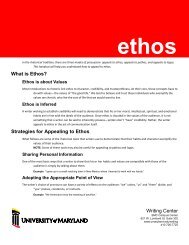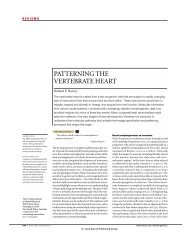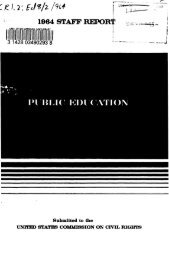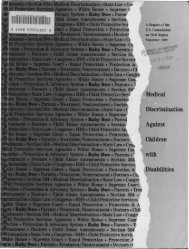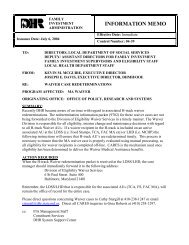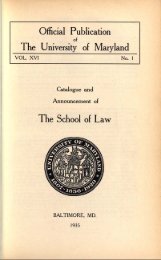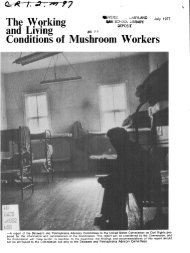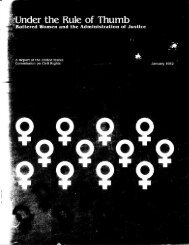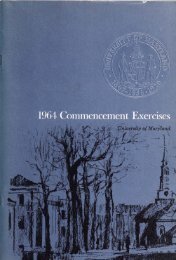Appendix GStaff Analysis of Data Perta<strong>in</strong><strong>in</strong>g to Faculty Desegregation, <strong>Fort</strong> <strong>Wayne</strong><strong>Community</strong> <strong>Schools</strong>—1976-77 School YearU.S. Commission on Civil Rights, Midwestern Regional OfficeBackgroundIn a Nov. 17, 1975, letter to FWCS Super<strong>in</strong>tendentLester L. Grile, Kenneth A. M<strong>in</strong>es, Region VDirector of <strong>the</strong> Office for Civil Rights (OCR) of<strong>the</strong> U.S. Department of Health, Education, andWelfare, stated:[that <strong>the</strong> school district's] practice of assign<strong>in</strong>gm<strong>in</strong>ority group faculty to schools attendedpredom<strong>in</strong>antly by m<strong>in</strong>ority group studentshas caused or <strong>in</strong>creased <strong>the</strong> racialidentifiability of 34 of <strong>Fort</strong> <strong>Wayne</strong>'s schools as<strong>in</strong>tended primarily for children of one race.Based on this determ<strong>in</strong>ation, M<strong>in</strong>es told Grile that<strong>the</strong> FWCS faculty assignment practices constituteda violation of Title VI of <strong>the</strong> Civil Rights Act of1964 and of HEW regulations, at 45 C.F.R. §80.OCR told <strong>the</strong> FWCS to submit a facultydesegregation plan that:must provide for <strong>the</strong> reassignment of facultyso that <strong>the</strong> ratio of m<strong>in</strong>ority group teachers <strong>in</strong>each school is substantially <strong>the</strong> same as <strong>the</strong>ratio throughout <strong>the</strong> District. (See appendix Aof this report, p. 2 of M<strong>in</strong>es letter.)Beyond that, accord<strong>in</strong>g to a Sept. 23, 1976, letterfrom Lloyd R. Henderson, Director of OCR's Elementaryand Secondary Education Division, toSupt. Grile, <strong>the</strong> district also agreed that:faculty will be assigned so that at each school<strong>the</strong>re will be a substantially equal admixtureof teachers accord<strong>in</strong>g to experience, teach<strong>in</strong>gskills, and post-graduate degrees***.In <strong>the</strong> same letter, Henderson also asked <strong>the</strong> districtto provide, by Oct. 15, 1976, <strong>the</strong> follow<strong>in</strong>g:a revised list of teacher assignments for1976-77 as <strong>the</strong>y become f<strong>in</strong>alized at <strong>the</strong>open<strong>in</strong>g of school. The list should <strong>in</strong>clude abreakdown of teachers assigned to eachschool accord<strong>in</strong>g to race, educational degrees,certificates and experience. (See appendix A,pp. 1,2 of Henderson letter.)Accord<strong>in</strong>g to documents received by <strong>the</strong> Commission'sMidwestern Regional Office from <strong>the</strong> OCRCleveland office, Super<strong>in</strong>tendent Grile sent onlypart of <strong>the</strong> requested data. The super<strong>in</strong>tendent'sdata <strong>in</strong>cluded <strong>the</strong> number of black teachers byschool and a list of <strong>the</strong> 18 black teachers transferredfor <strong>the</strong> 1976-77 school year, <strong>in</strong>clud<strong>in</strong>g <strong>the</strong>iryears of experience, degrees, and certificates. Thedata, however, perta<strong>in</strong>ed only to elementaryschools. Thus, accord<strong>in</strong>g to OCR records providedCommission staff, <strong>the</strong> district sent OCR no dataregard<strong>in</strong>g "educational degrees, certificates, andexperience" of <strong>the</strong> rema<strong>in</strong><strong>in</strong>g black elementaryteachers (43 o<strong>the</strong>r than <strong>the</strong> 18 for which datawere provided), and no data whatsoever regard<strong>in</strong>gwhite and o<strong>the</strong>r m<strong>in</strong>ority teachers <strong>in</strong> <strong>the</strong> system,<strong>in</strong>clud<strong>in</strong>g all teachers at <strong>the</strong> secondary level.Five and one-half months later, on Mar. 18, 1977,Orrie Barr, of <strong>the</strong> OCR Cleveland office, wroteSuper<strong>in</strong>tendent Grile, ask<strong>in</strong>g that he send, by Apr.15, <strong>the</strong> rest of <strong>the</strong> data requested by Henderson <strong>in</strong>September 1976, and projections for <strong>the</strong> 1977-78school year.Accord<strong>in</strong>g to documents received from OCR, <strong>the</strong>super<strong>in</strong>tendent responded on Apr. 13 with a list ofall elementary schools show<strong>in</strong>g numbers ofteachers <strong>in</strong> each school by race, degrees earned,years of experience, and certification. Aga<strong>in</strong>, nocomparable data were supplied regard<strong>in</strong>g secondaryschools.Analysis of DataBased on <strong>the</strong>se data Commission staff have calculated,for each elementary school, <strong>the</strong> percentageof m<strong>in</strong>ority teach<strong>in</strong>g staff, percentage of teachershav<strong>in</strong>g master's degrees, and <strong>the</strong> average numberof years teach<strong>in</strong>g experience of teachers <strong>in</strong> eachschool, as compared with <strong>the</strong> m<strong>in</strong>ority percentageof each school's total student enrollment (see tableG-l of this appendix).In general <strong>the</strong> data <strong>in</strong>dicate that <strong>the</strong> 12 elementaryschools hav<strong>in</strong>g high m<strong>in</strong>ority enrollment (morethan <strong>the</strong> district-wide elementary m<strong>in</strong>ority enrollmentpercentage of 20.8 percent) also tend tohave higher proportions of m<strong>in</strong>orities amongteach<strong>in</strong>g staff, lower proportions of all teachers44
hav<strong>in</strong>g master's degrees, and less experiencedteach<strong>in</strong>g staffs. (Data on certification of teacherswere not analyzed because <strong>in</strong>formation <strong>in</strong>terpret<strong>in</strong>g<strong>the</strong>se data was not <strong>in</strong>cluded <strong>in</strong> <strong>the</strong> district'slist.)Specifically, all but two of <strong>the</strong> high m<strong>in</strong>ority elementaryschools also have more than <strong>the</strong> districtwideproportion of m<strong>in</strong>ority teachers. By comparison,27 of <strong>the</strong> 33 low m<strong>in</strong>ority elementaryschools have less than <strong>the</strong> district-wide proportionof m<strong>in</strong>ority teachers. While 8 of <strong>the</strong> 12 highm<strong>in</strong>ority schools have a proportion of teacherswith master's degrees which is less than <strong>the</strong> district-wideaverage, <strong>the</strong> opposite is true of <strong>the</strong> lowm<strong>in</strong>ority schools. Twenty-two of <strong>the</strong> district's 33low m<strong>in</strong>ority schools have a proportion of teacherswith master's degrees which is more than <strong>the</strong> district-wideaverage. Similarly, 8 of <strong>the</strong> 12 highm<strong>in</strong>ority schools have faculties with less than <strong>the</strong>district-wide average years of teach<strong>in</strong>g experience,while 21 of <strong>the</strong> district's 33 low m<strong>in</strong>ority schoolshave faculties with more than <strong>the</strong> district-wideaverage years of teach<strong>in</strong>g experience.When Commission staff submitted <strong>the</strong>se data to<strong>the</strong> Chi Square test of statistical significance, <strong>the</strong>follow<strong>in</strong>g relationships were found:a) The relationship between <strong>the</strong> race of teachersand <strong>the</strong> racial composition of <strong>the</strong> schools towhich <strong>the</strong>y were assigned was significant at <strong>the</strong>.001 level (x 2= ll.O5). That is, m<strong>in</strong>ority teacherswere disproportionately assigned to schools hav<strong>in</strong>ghigh m<strong>in</strong>ority enrollment.b) The relationship between teachers' academiccredentials and racial composition of <strong>the</strong>ir assignedschools was significant at <strong>the</strong> .001 level(X 2 =14.55). That is, teachers hav<strong>in</strong>g master'sdegrees were disproportionately assigned toschools hav<strong>in</strong>g low m<strong>in</strong>ority enrollments.c) The relationship between teachers' length ofteach<strong>in</strong>g experience and <strong>the</strong> racial compositionof <strong>the</strong>ir assigned schools was significant at <strong>the</strong>.001 level (x 2 =18.56). That is, teachers hav<strong>in</strong>gmore years of experience were disproportionatelyassigned to schools hav<strong>in</strong>g low m<strong>in</strong>ority enrollments.It should be noted that tests of statistical significance,such as <strong>the</strong> Chi Square, <strong>in</strong>dicate nei<strong>the</strong>r<strong>the</strong> causes nor <strong>in</strong>tent beh<strong>in</strong>d <strong>the</strong> relationshipsunder exam<strong>in</strong>ation. "Statistical significance" refersto <strong>the</strong> likelihood that a given relationship betweentwo variables is a random occurrence. In each of<strong>the</strong> three relationships between variables exam<strong>in</strong>edhere, <strong>the</strong>refore, <strong>the</strong> likelihood that any of <strong>the</strong>sepatterns occurred by chance is less than one outof 1,000.The Chi Square tests reported here were basedupon data for each of <strong>the</strong> district's 757 reportedelementary teachers, and are presented <strong>in</strong> table G-2 of this appendix.The unequal distribution of teacher characteristics<strong>in</strong> <strong>the</strong> schools is directly related to <strong>the</strong> racial compositionof student bodies. In <strong>the</strong> case of assignmentof m<strong>in</strong>ority teachers, <strong>the</strong> effect is to contributeto <strong>the</strong> identifiability of some schools asbe<strong>in</strong>g <strong>in</strong>tended for one racial group. In <strong>the</strong> case of<strong>the</strong> distribution of teachers' credentials and experienceamong schools, <strong>the</strong> effect is to provide alower level of resources to schools currently hav<strong>in</strong>ghigh m<strong>in</strong>ority enrollments.Based on this analysis, it is clear that among elementaryschools <strong>in</strong> <strong>the</strong> FWCS <strong>the</strong>re is not yet "asubstantially equal admixture of teachers" accord<strong>in</strong>gto <strong>the</strong>ir race, experience, and credentials.45



